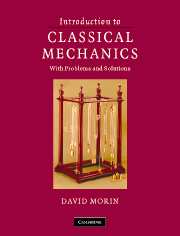Book contents
- Frontmatter
- Contents
- Preface
- 1 Strategies for solving problems
- 2 Statics
- 3 Using F = ma
- 4 Oscillations
- 5 Conservation of energy and momentum
- 6 The Lagrangian method
- 7 Central forces
- 8 Angular momentum, Part I (Constant L^)
- 9 Angular momentum, Part II (General L^)
- 10 Accelerating frames of reference
- 11 Relativity (Kinematics)
- 12 Relativity (Dynamics)
- 13 4-vectors
- 14 General Relativity
- Appendix A Useful formulas
- Appendix B Multivariable, vector calculus
- Appendix C F = ma vs. F = dp/dt
- Appendix D Existence of principal axes
- Appendix E Diagonalizing matrices
- Appendix F Qualitative relativity questions
- Appendix G Derivations of the Lv/c2 result
- Appendix H Resolutions to the twin paradox
- Appendix I Lorentz transformations
- Appendix J Physical constants and data
- References
- Index
Appendix F - Qualitative relativity questions
- Frontmatter
- Contents
- Preface
- 1 Strategies for solving problems
- 2 Statics
- 3 Using F = ma
- 4 Oscillations
- 5 Conservation of energy and momentum
- 6 The Lagrangian method
- 7 Central forces
- 8 Angular momentum, Part I (Constant L^)
- 9 Angular momentum, Part II (General L^)
- 10 Accelerating frames of reference
- 11 Relativity (Kinematics)
- 12 Relativity (Dynamics)
- 13 4-vectors
- 14 General Relativity
- Appendix A Useful formulas
- Appendix B Multivariable, vector calculus
- Appendix C F = ma vs. F = dp/dt
- Appendix D Existence of principal axes
- Appendix E Diagonalizing matrices
- Appendix F Qualitative relativity questions
- Appendix G Derivations of the Lv/c2 result
- Appendix H Resolutions to the twin paradox
- Appendix I Lorentz transformations
- Appendix J Physical constants and data
- References
- Index
Summary
Is there such a thing as a perfectly rigid object?
Answer: No. Since information can move no faster than the speed of light, it takes time for the atoms in the object to communicate with each other. If you push on one end of a rod, then the other end won't move right away. If it did move right away, then these “pushing” and “moving” events would be spacelike separated (see Section 11.6), which would mean that there would exist a frame in which the “moving” event occurred before the “pushing” event. This is a violation of causality, so we conclude that the other end doesn't move right away.
2. How do you synchronize two clocks that are at rest with respect to each other?
Answer: One way is to put a light source midway between the two clocks and send out signals, and then set the clocks to a certain value when the signals hit them. Another way is to put a watch right next to one of the clocks and synchronize it with this clock, and then move the watch very slowly over to the other clock and synchronize that clock with it. Any time-dilation effects can be made arbitrarily small by moving the watch sufficiently slowly, because the time-dilation effect is second order in v.
- Type
- Chapter
- Information
- Introduction to Classical MechanicsWith Problems and Solutions, pp. 698 - 703Publisher: Cambridge University PressPrint publication year: 2008



